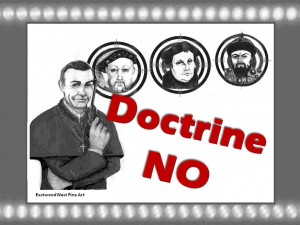Happy Anniversary to All Our Jesuit Readers
Posted in General, On This Day on September 26th, 2009 by Eugene Finerman – 4 Comments September 27, 1540: The Church’s Secret Weapon
September 27, 1540: The Church’s Secret Weapon
What if James Bond had a MBA as well as a license to kill? The very idea may be too horrifying for you, but it wasn’t for Pope Paul III. On this day in 1540, the Pontiff gave his authorization-and evidently his blessing-to the Society of Jesus. As we now know, the founding of the Jesuits was a major event in the history of exorcism. Finally, there were priests as literate as the Devil. At the time, however, the Pope was interested in only one exorcism: a certain Professor Luther.
Upon becoming Pope, Paul III had attempted reconciliation with the Protestants. His approach was reassuring, saying in effect, “You now are dealing with an adult. At least, I am not a de Medici.” His holier-than-them attitude was in the highest standards of hypocrisy. Born Alessandro Farnese, he had become a Cardinal at the age of 25 because his sister was the mistress of Pope Julius II. And the young Cardinal never lacked a social life, either. As Pope, he appointed two of his grandsons as Cardinals. Nevertheless, he was an improvement over his predecessors. Paul III viewed the Church in a global role. The de Medici Popes had shown the political perspective of Florentine aldermen.
To his disappointment, however, Paul III was not the answer to the Protestants’ prayers. The Princes of Northern Europe-and that extrovert in England-had discovered a profound spirituality in confiscating the Church’s wealth and they were not ready to repent a penny. (One family of minor princes in Brandenburg, Germany had subsisted on the salaries and graft of Church offices: a bishopric here, a priory there, a Grand Master of this and that. Then the Reformation inspired them: why settle for a tithe of a tithe when you can wring the entire archdiocese. After that, the Hohenzollerns would not be so minor.)
Since Paul III could not coax the Protestants into reconciliation, he would scheme them into oblivion. The Pope proved a dynamo of plans and plots. He cured France’s Francis I of his Protestant leanings by a form of faith-healing called bribes; the Church lost income but kept France. The Pope also negotiated a peace between the usually warring France and the Holy Roman Empire; Catholic nations should not slaughter each other when there were Protestants to kill. Acknowledging that the Church’s miserable reputation had incited the Protestants, the Pope summoned the Council of Trent to undertake desperately overdue reforms. (The Farnese would condemn nepotism by other families.)
And the Jesuits certainly fit into the Pope’s scheme of things. Here was a religious order that reflected the best of the Renaissance’s virtues and vices. The brilliant and highly trained Jesuits could convert, subvert, charm and kill with equal aplomb. Yes, they were fanatics-what else could you expect from an organization founded by Spaniards-but they were fanatics with taste. They dismissed the Inquisition’s wholesale persecutions as just a vulgar waste of kindling. The Jesuits preferred knowing the right people, whether to cultivate or eradicate them.
Their sinister charm proved successful in preventing further defections to Protestantism. Confiscating the Church’s wealth had an obvious appeal to the aristocracy of Poland and Hungary, but the Jesuits made themselves irresistible and indispensable to the ruling classes. And if the nobles remained Catholic, so did their peasants.
Of course, the Jesuits also had their failures but they were always spectacular. They never did manage to assassinate Elizabeth I or foist Mary Stuart on to the throne of England. The Jesuits did succeed in overthrowing Tsar Fedor II in 1605, but one coup was insufficient to convert Russia. They also backed the wrong side in a Japanese civil war in 1600. The winning warlord, taking over the Shogunate and rule of the country, proved very vindictive. Of course, the Jesuits were expelled from Japan but so were all Europeans. The Jesuits’ interference would result in two centuries of Japanese isolation.
Today, the Jesuits are generally regarded as benevolent activists. Given their erudite reputation, they are often considered liberals. Yet, there remain traces of their notoriety and you can find them in high school literature. Would “The Three Musketeers” have faced such perils if Cardinal Richelieu had been a Franciscan?